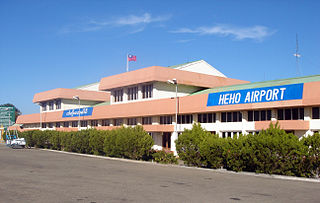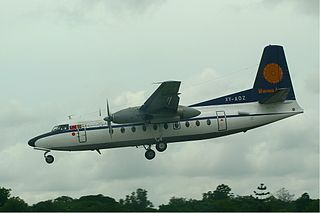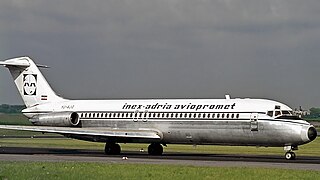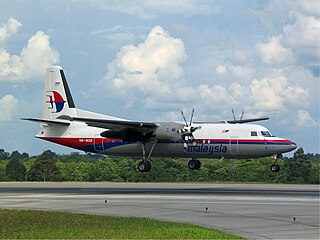
Luxair Flight 9642 (LG9642/LGL9642) was a scheduled international passenger flight from Berlin, Germany, to Luxembourg City, Luxembourg, operated by Luxembourg national airline Luxair. On 6 November 2002, the aircraft operating the flight, a Fokker 50 registered as LX-LGB, lost control and crashed onto a field during an attempted landing at the airport. Out of 22 passengers and crew members on board, only two people survived. The crash is the deadliest aviation disaster to occur in Luxembourg.

American Airlines Flight 157, a Douglas DC-6, departed on November 29, 1949, from New York City bound for Mexico City with 46 passengers and crew. After one engine failed in mid-flight, a series of critical mistakes by the flight crew caused the pilot to lose control of the plane during the final approach to a routine stopover at Love Field in Dallas, Texas. The airliner slid off the runway and struck a parked airplane, a hangar, and a flight school before crashing into a business across from the airport. 26 passengers and two flight attendants died. The pilot, co-pilot, flight engineer, and 15 passengers survived.

Air Bagan Limited was an airline headquartered in Bahan Township, Yangon, Myanmar. It operated domestic scheduled services within Myanmar, as well as to Thailand. Its main bases were Yangon International Airport and Mandalay International Airport.

Sosoliso Airlines Flight 1145(SO1145/OSL1145) was a scheduled Nigerian domestic passenger flight from Nigeria's capital of Abuja (ABV) to Port Harcourt (PHC). At about 14:08 local time on 10 December 2005, Flight 1145 from Abuja crash-landed at Port Harcourt International Airport. The aircraft, a McDonnell Douglas DC-9-32 with 110 people on board, slammed into the ground and burst into flames. Immediately after the crash, seven survivors were recovered and taken to hospitals, but only two people survived.

Heho Airport is an airport serving Heho, a town in Kalaw Township, Taunggyi District, Shan State, Myanmar. It is the main airport serving Inle Lake and Taunggyi the former of the top tourist destinations of Myanmar.
Myanmar National Airlines, formerly Union of Burma Airways, Burma Airways, and Myanma Airways, is a state-owned airline and the flag carrier of Myanmar, based in Yangon. Founded in 1948, the airline operates scheduled services to all major domestic destinations and to regional destinations in Asia. Its main base is Yangon International Airport.

Vietnam Airlines Flight 815 was a scheduled Vietnam Airlines flight which crashed on final approach to Phnom Penh International Airport in Cambodia on 3 September 1997. The Soviet-built Tupolev Tu-134B-3 airliner crashed approximately 800 metres short of the Phnom Penh runway, killing 65 of the 66 people on board. As of 2023, it remains the deadliest accident in Cambodian History. Upon investigation, the crash was determined to have been the result of improper actions by the pilot.

Turkish Airlines Flight 634 was a scheduled domestic passenger flight from Turkish Airlines' hub at Istanbul Atatürk Airport to Diyarbakır Airport in southeastern Turkey. On 8 January 2003 at 20:19 EET, the aircraft operating the flight, a British Aerospace Avro RJ100, struck the ground on final approach approximately 900 metres (3,000 ft) short of the runway threshold during inclement weather conditions. In the following collision with a slope, a post-crash fire broke out, killing 75 of the 80 occupants, including the entire crew.

EgyptAir Flight 843 was a flight from Cairo International Airport to Tunis–Carthage International Airport. On 7 May 2002, the Boeing 737-566 on the route crashed into a hill near Tunis–Carthage International Airport. Of the 6 crew members and 56 passengers, 3 crew members and 11 passengers died, making a total of 14 fatalities.

Myanma Airways Flight 635 was a scheduled domestic passenger flight from Yangon to Tachileik in eastern Myanmar that was operated by a Fokker F-27 Friendship owned by Myanmar's flag carrier Myanma Airways. On 24 August 1998, during its descent to Tachileik the flight went missing over a hill approximately two miles (3.2 km) from the airport. Search and rescue team later found the wreckage of the aircraft. The accident killed all 36 passengers and crew.

Kish Air Flight 7170 was a scheduled international passenger flight from Kish Island in Iran to Sharjah, United Arab Emirates, operated by Iranian airline Kish Air. On February 10, 2004, the aircraft serving the route, a Fokker 50, lost control and crashed onto terrain while on approach to Sharjah International Airport. A total of 43 out of 46 people on board were killed in the crash, making it the deadliest air disaster involving the Fokker 50.

Inex-Adria Aviopromet Flight 450, JP 450, was an international charter flight from Tivat in the Socialist Federal Republic of Yugoslavia to Prague, Czechoslovakia which crashed in the Prague suburb of Suchdol on October 30, 1975, at 09:20 AM. The McDonnell Douglas DC-9-32 with 115 passengers and 5 crew on board descended, under Instrument Meteorological Conditions (IMC), below defined Minimum Descent Altitude (MDA) during the final approach to Prague Ruzyně Airport RWY 25, entered a gorge above Vltava river, and was unable to outclimb the rising terrain. 75 of the 120 occupants died during the crash itself while 4 others died in Hospital. The accident remains the worst aviation disaster on the Czech Republic soil.

On 4 April 2011, Georgian Airways Flight 834, a Bombardier CRJ100 passenger jet of Georgian Airways operating a domestic flight from Kisangani to Kinshasa in Democratic Republic of Congo (DRC) crashed while attempting to land at Kinshasa Airport. The aircraft, which was chartered by the United Nations, was trying to land during a thunderstorm. Of the 33 people on board, only one person survived. It remains as United Nations' deadliest aviation disaster. It is also the third deadliest air disaster involving the CRJ100/200, behind Comair Flight 5191 and China Eastern Airlines Flight 5210.

Aeroflot Flight 6502 was a Soviet domestic passenger flight operated by a Tupolev Tu-134A from Sverdlovsk to Grozny, which crashed on 20 October 1986; 70 of the 94 passengers and crew on board were killed. Investigators determined the cause of the accident was pilot negligence.

Malaysia Airlines Flight 2133 (MH2133/MAS2133) was a scheduled domestic passenger flight from Kota Kinabalu to Tawau, operated by Malaysia's flag carrier Malaysia Airlines. On 15 September 1995, the Fokker 50 carrying 53 people flew into a shanty town after the pilots failed to stop the aircraft while landing in Tawau, killing 32 of the 49 passengers and 2 of the 4 crew on board. This was the first hull loss of a Fokker 50.

On 5 August 1984, a Biman Bangladesh Airlines Fokker F27-600 crashed into a marsh near Zia International Airport in Dhaka, Bangladesh while landing in poor weather. The aircraft was performing a scheduled domestic passenger flight between Patenga Airport, Chittagong and Zia International Airport, Dhaka.

Aero Flight 217 was a domestic passenger flight from Helsinki, Finland, to Mariehamn in the autonomous territory of Åland, operated by the Finnish flag carrier Aero O/Y. On 8 November 1963, the aircraft serving the flight crashed in poor visibility while attempting to land on a non-precision approach at Mariehamn Airport in the municipality of Jomala, resulting in the deaths of 22 people out of 25 on board. The crash remains the second most deadly aviation accident in Finland, the first being Aero Flight 311 almost two years earlier.

Trans-Colorado Airlines Flight 2286 was a scheduled domestic passenger flight from Denver, Colorado, to Durango, Colorado, operated for Continental Express by Trans-Colorado Airlines. On January 19, 1988, Flight 2286 crashed onto terrain near Bayfield, Colorado, while on approach to Durango-La Plata County Airport. Out of the seventeen people on board, nine were killed, including both crew members.

















